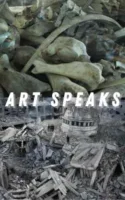During my recent visit to the Constitutional Court in Hillbrow, I encountered a powerful testament to the role of art in championing justice and peace. Among the standout pieces was Pitika Ntuli’s bone sculpture, “Gaza: Lest We Forget” (2015). This artwork, initially understated, unravels a compelling narrative advocating for peace and solidarity with Palestinians amidst ongoing conflict and genocide.
The sculpture is a profound reflection on the 2014 Gaza massacre, where the Israeli military’s actions led to the tragic loss of 1328 Palestinian lives, including children. Crafted from bones and displayed as if amidst the rubble of a demolished structure, it resonates with the grief and loss of the Palestinian people. This visual metaphor becomes even more poignant considering the ongoing violence in Gaza, including the recent attack on October 7, 2023, which claimed the lives of 11070 Palestinians.
Ntuli’s work not only commemorates past tragedies but also serves as a powerful call for peace, freedom, and the end of the ongoing genocide in Palestine. The adjacent artist’s statement echoes this sentiment: “Like you, we have bled where no wounds were seen. We rose against nocturnal beasts. Now, we ride on the crest of a wave of freedom in our land. You, too, will ride your wave. If we stand together.” This message, transcending time and place, is a reminder of our shared humanity and the universal desire for freedom and peace.
The comparison to South Africa’s struggle against apartheid lends additional depth to Ntuli’s sculpture. Both the Israeli-Palestinian conflict and apartheid in South Africa involve narratives of displacement, occupation, and a fight for basic human rights. Artists like Miriam Makeba, Helen Sebidi, and Hugh Masekela once used their voices to challenge apartheid; Ntuli’s sculpture continues this legacy by advocating for the Palestinian cause.
Displayed in the Constitutional Court, a symbol of human rights and justice, the sculpture becomes a beacon for peace and solidarity. This location, steeped in the history of struggle and resistance, enhances the artwork’s call for freedom and the protection of innocent lives in Palestine and beyond.
Ntuli describes his work as a spiritual act akin to our community’s tradition of seeking wisdom through bones. His sculpture is more than a visual spectacle; it is a catalyst for dialogue about justice, humanity, and the power of art to unite us in the face of adversity.
As young people, especially those active on platforms like TikTok, engage with this artwork, they are invited to reflect on how art and justice can come together to create a more peaceful, equitable world. The sculpture is not just a reminder of past events but a living call to action, urging us to stand in solidarity with those suffering under oppression and to work tirelessly for their freedom and the liberation of their land.
Question: How can we, as individuals and as a community, use the power of art to inspire change and foster a global culture of peace, solidarity, and justice?
Have your say in our Annual Survey AND stand a chance to win awesome prizes – https://live.fundza.mobi/competitions/fundzas-annual-survey/



